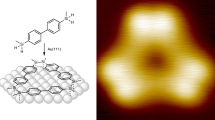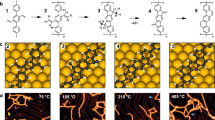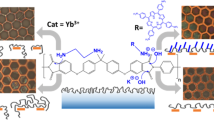Summary
Living anionic polymerization of isoprene on a silicon wafer was initiated by treatment of a 1,1-diphenylethylene surface-bound monolayer with n-butyllithium (growth from). The corresponding 1,1 diphenylhexyllithium derivative was used to initiate isoprene polymerization. The poly(isoprenyl)lithium chain ends were functionalized by addition of ethylene oxide to give a hydroxy-terminated polyisoprene brush. The thickness of the polymer brush was 9.5 ± 1.2 nm by ellipsometry. Grafting living chain ends to the 1,1-diphenylethylene monolayer and surface grafting of telechelic polymers were used for comparison (growth to). The polymer brushes were characterized by XPS, contact angle measurements, ATR-IR, and AFM.
Similar content being viewed by others
Author information
Authors and Affiliations
Additional information
Received: 1 November 2000/Revised version: 23 November 2000/Accepted: 28 November 2000
Rights and permissions
About this article
Cite this article
Quirk, R., Mathers, R. Surface-initiated living anionic polymerization of isoprene using a 1,1-diphenylethylene derivative and functionalization with ethylene oxide. Polymer Bulletin 45, 471–477 (2001). https://doi.org/10.1007/s002890170100
Issue Date:
DOI: https://doi.org/10.1007/s002890170100




